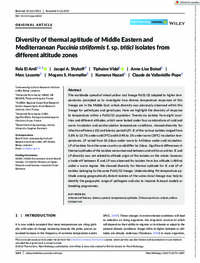Diversity of thermal aptitude of Middle Eastern and Mediterranean Puccinia striiformis f. sp. tritici isolates from different altitude zones

Authors:
The worldwide spread of wheat yellow rust lineage PstS1/S2 adapted to higher temperatures prompted us to investigate how diverse temperature responses of this lineage are in the Middle East, where diversity was previously observed within this lineage for pathotypes and genotypes. Here we highlight the diversity of response to temperature within a PstS1/S2 population. Twenty-six isolates from eight countries and different altitudes, which were tested under four combinations of cold and warm incubation and postincubation temperature conditions, showed diversity for infection efficiency (IE) and latency period (LP). IE of the various isolates ranged from 5.8% to 13.7% under cold (5°C) and 0.04% to 1% under warm (20°C) incubation temperatures. LP varied from 10.2 days under warm to 4.43 days under cold incubation. LP of isolates from the same country could differ by 2 days. Significant differences in thermal aptitudes of the isolates were observed between and within countries. IE and LP diversity was not related to altitude origin of the isolates on the whole; however, a trade-off between IE and LP was observed for isolates from low altitude (<400 m) under a warm regime. We showed diversity for thermal aptitude for IE and LP of isolates belonging to the same PstS1/S2 lineage. Understanding Pst temperature aptitude among geographically distant isolates of the same clonal lineage may help to identify the geographic range of pathogens and also to improve forecast models or breeding programmes.
